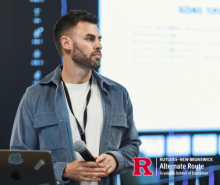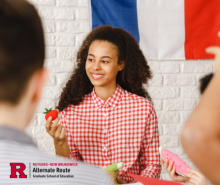Tips for New Teachers Who Want Their Special Education Students to Thrive

As customary during our spring phase course, Rutgers Alternate Route held an online Twitter Chat to help new teachers enrolled in the program increase awareness of inclusion strategies for helping special education students thrive. Coordinated on a Saturday morning to maximize the synchronous participation of program candidates, the event featured an educator panel of guest commentators seasoned on the practice of serving students with IEPs. The panel included school leaders like Christopher Harris, a principal based in Pennsauken, New Jersey, who has been volunteering as a guest commentator for three years. Teachers Eric Fieldman and Jennifer Kressler Duda also marked three years of service on the panel. Eric is a Collingswood High School Teacher of Special Education and Jennifer Kressler Duda is a Special Education Teacher at the Mercer County Special Services School District helping autistic students build coding and robotics skills. Joining for the second year, we had Nicole Biscotti, educator and author of I Can Learn When I’m Moving: Going to School With ADHD - a book she co-wrote with her son. Finally, there was Dr. Jacinta Calzada-Mayronne, known as @DrCalzy in the Twittersphere, who made her debut as a guest commentator bringing her wealth of experience as a former Special Education Coordinator for Friendship Public Charter School and her current education leadership perspective as Assistant Principal for Stafford County Public Schools in Virginia. We were especially proud to have Jacinta join us because she earned her teaching certification through Rutgers Alternate Route and returned home to pay it forward to new teachers.
Prior to the start of the discussion, we asked candidates to assess their knowledge, beliefs, and capacity related to various areas of special education. The overwhelming majority of candidates started from assets-based perceptions of their students with learning disabilities, expressing favorable beliefs about their ability to learn. Ninety-seven percent of candidates disagreed with the statement "My content is too difficult for special education students." Also, eighty-six percent of new teachers correctly noted that it is their responsibility to accommodate these unique learners.
The Twitter chat then unfolded with the teacher candidates and panelists sharing their experiences and insights on inclusion practices. The exchange addressed the following topics:
- Challenges to inclusion
- Empowering students with disabilities to self-advocate
- Opportunities for students with ADHD
- Behavior and management for students with IEPs
At the end of the discussion, we invited candidates to share what they learned or offer general reactions to the chat. Most significant is that 99% felt knowledgeable or very knowledgeable about ways to make their class inclusive for students with learning disabilities after participating in the session. Further, of the 17 candidates who, at the beginning of the chat, reported that they were not at all knowledgeable about inclusion strategies, only three indicated they were still not knowledgeable about how to serve their students with learning disabilities when asked at the end of the chat. A sampling of candidate comments follows below.
- "This was great! Thankful for the new professionals I have followed for a multitude of educational chat!"
- "I really enjoyed hearing from both professionals and other teachers on this topic. Finding strategies that benefit all students, and especially our special education students, is a top priority for me as an educator. All students deserve an education and opportunity for success."
- "So many great modifications shared, and ways to empower special ed students- I will definitely be adding to my toolkit!"
- "This session was a useful reminder of many things that I can do to make my classroom more inclusive. I loved the video in question 4. It made me reflect on strategies to help my students with ADHD. As a HS teacher, sometimes I forget that older students also struggle with ADHD because they "mask it" better than little kids (they don't run, jump or play with fidgets). So, this was a reminder to me that even though they do not show it in typical ways, the condition is still affecting them. Also, my classmates shared interesting strategies that I will incorporate in my classroom."
Access the full Twitter Chat and tips here.
Continue the conversation with colleagues at your school about serving students with learning disabilities by checking out these previously published blog posts addressing this topic.
- 11 Articles to Help New Teachers Build Inclusive Classrooms for Special Education Students
- How New Teachers Can Support Special Education Students in General Education Settings
- 39 Peer-Recommended Resources for Special Education Teachers
- 12 Free EdTech Apps For Special Ed Alternate Route Teachers
- NJ Alternate Route Teachers on Meeting the Needs of Special Education Students

 Sharlene Laud has extensive experience in education from K-12 to higher education and holds a Doctorate in Education from the Rutgers Graduate School of Education. Dr. Laud is the Assistant Director of the Rutgers-GSE Alternate Route Program in the Department of Learning and Teaching. Follow her on X @sharlene_laud
Sharlene Laud has extensive experience in education from K-12 to higher education and holds a Doctorate in Education from the Rutgers Graduate School of Education. Dr. Laud is the Assistant Director of the Rutgers-GSE Alternate Route Program in the Department of Learning and Teaching. Follow her on X @sharlene_laud





